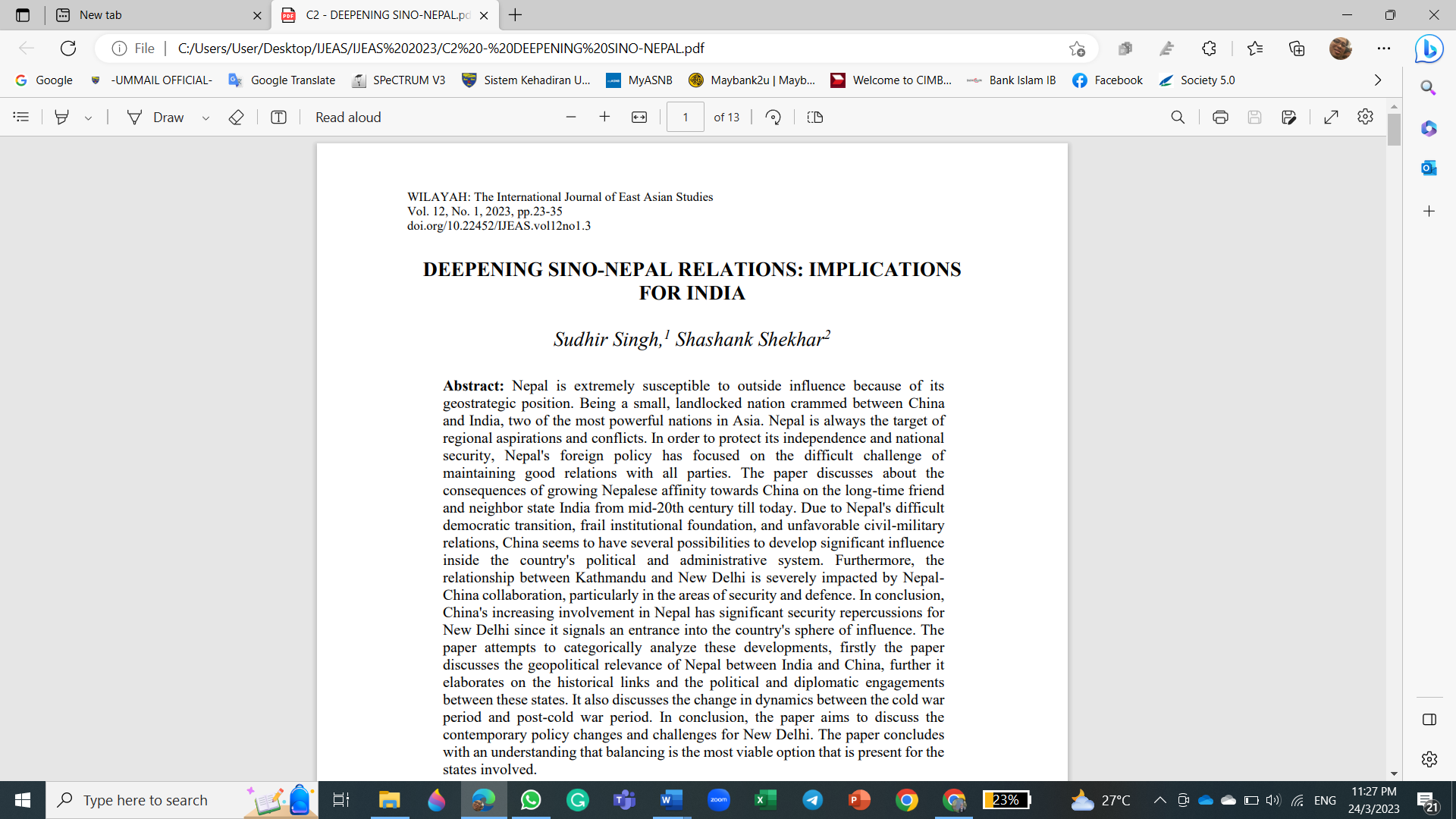DEEPENING SINO-NEPAL RELATIONS: IMPLICATIONS FOR INDIA
Main Article Content
Abstract
Nepal is extremely susceptible to outside influence because of its
geostrategic position. Being a small, landlocked nation crammed between China
and India, two of the most powerful nations in Asia. Nepal is always the target of
regional aspirations and conflicts. In order to protect its independence and national
security, Nepal's foreign policy has focused on the difficult challenge of
maintaining good relations with all parties. The paper discusses about the
consequences of growing Nepalese affinity towards China on the long-time friend
and neighbor state India from mid-20th century till today. Due to Nepal's difficult
democratic transition, frail institutional foundation, and unfavorable civil-military
relations, China seems to have several possibilities to develop significant influence
inside the country's political and administrative system. Furthermore, the
relationship between Kathmandu and New Delhi is severely impacted by NepalChina collaboration, particularly in the areas of security and defence. In conclusion,
China's increasing involvement in Nepal has significant security repercussions for
New Delhi since it signals an entrance into the country's sphere of influence. The
paper attempts to categorically analyze these developments, firstly the paper
discusses the geopolitical relevance of Nepal between India and China, further it
elaborates on the historical links and the political and diplomatic engagements
between these states. It also discusses the change in dynamics between the cold war
period and post-cold war period. In conclusion, the paper aims to discuss the
contemporary policy changes and challenges for New Delhi. The paper concludes
with an understanding that balancing is the most viable option that is present for the
states involved.
Downloads
Article Details

This work is licensed under a Creative Commons Attribution-NonCommercial 4.0 International License.
Copyright
Submission of a manuscript to the WILAYAH implies that the submitted work has not been published before (except as part of a thesis or report or abstract), that it is not under consideration for publication elsewhere; that all co-authors have approved its publication. The WILAYAH : International Journal of East Asian Studies adopts CC BY license. As such, we would be grateful if an acknowledgement accompanies the republication that the work was originally published in WILAYAH. The editors will ensure digital preservation of access to the journal content by the Journal depository section.
Disclaimer
Although the Department of East Asian Studies is the publisher of the WILAYAH : International Journal of East Asian Studies, the views presented in the WILAYAH are entirely those of the contributors and do not reflect the official stand of the Department of East Asian Studies. The Department does not hold itself responsible for the accuracy of any article published. Publisher and co-publishers assume no responsibility, nor by the editors for any injury and/or damage to persons or property as a result of any actual or alleged libellous statements, infringement of intellectual property or privacy rights, or products liability, whether resulting from negligence or otherwise, or from any use or operation of any ideas, instructions, procedures, products or methods contained in the material therein.
References
Orton, A. (2021). India’s Borderland Disputes. Epitome Books.
Donnell; F. O.’ (2018). Stabilizing Sino-Indian security relations: managing the strategic rivalry after Doklam. Rawat Publications
Sigdel, A. (2018) China’s growing footprint in Nepal: challenges and opportunities for
India. Issues Briefs and Special Reports
Adhikari, M. (2012). Between the Dragon and the Elephant: Nepal’s Neutrality Conundrum. Indian Journal of Asian Affairs, 25(1/2), 83–97.
Sharma, B.P. (2018). China-Nepal Relations: A Cooperative Partnership in Slow Motion. China Quarterly of International Strategic Studies. 4 (3), 439–455
Khadka, N. (1999). Chinese Foreign Policy toward Nepal in the Cold War Period: An Assessment. China Report, 35(1), 61–81.
Ghimire, Y. (2012). Big Power Deal Gives Chinese a Foothold in Nepal. Straits Times
Indonesia, 10 March 2012, at http://www.thejakartaglobe.com/economy/big-pow er-dealgives-chinese-a-foothold-in-nepal/503
Singh, J. (2011). Indian Air Power. In OLsan, J.A. (ed.) Global Air Power. Potamac Books.
Han, Z. (2022). India enhances interactions with Quad members, but eyes balance between major powers to reap benefit - Global Times. Retrieved December 27, 2022, from www.globaltimes.cn website: https://www.globaltimes.cn/page/202209/1274863.shtml

